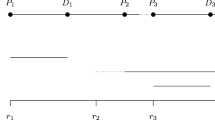Abstract
The dial-a-ride problem consists of designing a number of minimum-cost vehicle routes in a system of demand-dependent, collective people transportation. Quality is ensured by taking into account service level requirements. However, little research has been conducted into the effect of service level variations on operational costs incurred by service providers. This study investigates the evolution of operational costs for 78 combinations of two service level parameters, being the maximum deviation from a user’s preference time and the relative maximum exceedance of a user’s direct ride time. A distinction is made between various operating circumstances, including the size of the service provider, the traffic conditions in the service area and the heterogeneity of the customers. The resulting tradeoffs between quality and costs should encourage service providers to make informed decisions regarding potential changes in the service level they offer. The sensitivity analysis in this paper is performed on well-known benchmark data from literature and applies a state-of-the-art deterministic annealing metaheuristic to compute operational costs.






Similar content being viewed by others
References
Anderson DR, Sweeney DJ, Williams TA, Freeman J, Shoesmith E (2010) Statistics for business and economics. CENGAGE Learning Business Press, Boston
Ben-Akiva M, Benjamin J, Lauprete GJ, Polydoropoulou A (1996) Impact of advanced public transportation systems on travel by dial-a-ride. Transp Res Rec 1557:72–79
Braekers K, Caris A, Janssens GK (2014) Exact and meta-heuristic approach for a general heterogeneous dial-a-ride problem with multiple depots. Transp Res Part B: Methodol 67:166–186
Cordeau J-F (2006) A branch-and-cut algorithm for the dial-a-ride problem. Oper Res 54(3):573–586
Cordeau J-F, Gendreau M, Laporte G (1997) A tabu search heuristic for periodic and multi-depot vehicle routing problems. Networks 30:105–119
Cordeau J-F, Laporte G (2003) A tabu search heuristic for the static multi-vehicle dial-a-ride problem. Transp Res Part B: Methodol 37(6):579–594
Cordeau J-F, Laporte G (2007) The dial-a-ride problem: models and algorithms. Ann Oper Res 153(1):29–46
Cubillos C, Paolo F, Mascia M, Zunino C (2002) On user requirements and operator purposes in dial-a-ride services. In: Proceedings of the 9th meeting of the EURO working group on transportation, pp 677–684
Jaw J-J, Odoni AR, Psaraftis HN, Wilson NHM (1986) A heuristic algorithm for the multi-vehicle advance-request dial-a-ride problem with time windows. Transp Res Part B: Methodol 20:243–257
Lin S, Kernighan BW (1973) An effective heuristic algorithm for the traveling salesman problem. Oper Res 21(2):498–516
Marković N, Nair R, Schonfeld P, Miller-Hooks E, Mohebbi M (2014) Optimizing dial-a-ride services in maryland. In: TRB 2014: 93th annual meeting of the transportation research board, Washington D.C
Paquette J, Bellavance F, Cordeau J-F, Laporte G (2012) Measuring quality of service in dial-a-ride operations: the case of a Canadian city. Transportation 39(3):539–564
Paquette J, Cordeau J-F, Laporte G (2009) Quality of service in dial-a-ride operations. Comput Ind Eng 56(4):1721–1734
Parragh SN (2011) Introducing heterogeneous users and vehicles into models and algorithms for the dial-a-ride problem. Transp Res Part C: Emerg Technol 19(5):912–930
Parragh SN, Doerner KF, Hartl RF (2008) A survey on pickup and delivery problems. Part II: Transp Between Pickup Deliv Locat: Journal für Betriebswirtschaft 58(2):81–117
Parragh SN, Doerner KF, Hartl RF (2010) Variable neighborhood search for the dial-a-ride problem. Comput Oper Res 37(6):1129–1138
Potvin J-Y, Rousseau J-M (1995) An exchange heuristic for routing problems with time windows. J Oper Res Soc 46(12):1433–1446
Quadrifoglio L, Dessouky MM, Ordóñez F (2008) A simulation study of demand responsive transit system design. Transp Res Part A: Policy Pract 42(4):718–737
Røpke S, Cordeau J-F, Laporte G (2007) Models and branch-and-cut algorithms for pickup and delivery problems with time windows. Networks 49(4):258–272
Schilde M, Doerner KF, Hartl RF (2014) Integrating stochastic time-dependent travel speed in solution methods for the dynamic dial-a-ride problem. Eur J Oper Res 238(1):18–30
Verhetsel A, Van Hecke E, Thomas I, Beelen M, Halleux JM, Lambotte JM, Rixhon G, Mérenne-Schoumaker B (2009) Sociaal-economische enquête 2001: monografieën-pendel in België (in Dutch). FOD Economie, K.M.O., Middenstand en Energie. http://economie.fgov.be/nl/binaries/monografie_Pendel_N%20def%2007122009_tcm325-92955
Wolfler Calvo R, Colorni A (2007) An effective and fast heuristic for the dial-a-ride problem. 4OR: Q J Oper Res 5(1):61–73
Acknowledgments
This work is supported by the Interuniversity Attraction Poles Programme, initiated by the Belgian Science Policy Office (Research Project COMEX—Combinatorial Optimization: Metaheuristics & Exact Methods).
Author information
Authors and Affiliations
Corresponding author
Rights and permissions
About this article
Cite this article
Molenbruch, Y., Braekers, K. & Caris, A. Operational effects of service level variations for the dial-a-ride problem. Cent Eur J Oper Res 25, 71–90 (2017). https://doi.org/10.1007/s10100-015-0422-7
Published:
Issue Date:
DOI: https://doi.org/10.1007/s10100-015-0422-7




